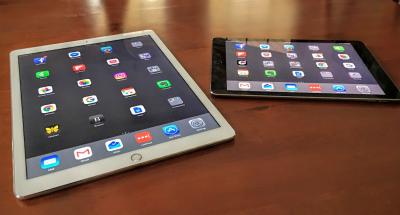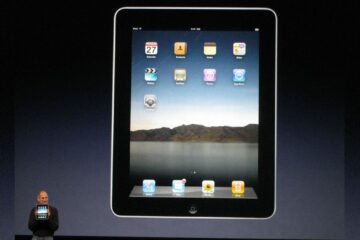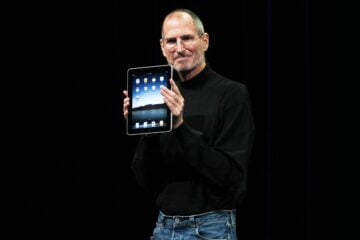
Though the iPad Pros resemble previous iPad models, they’re tricked out with a magnetic Smart Connector for use with a Smart Keyboard cover, and they also work with the new Apple Pencil stylus.
Apple’s emphasis with the iPad Pro is on productivity, an angle I’ve embraced with gusto. Though I have long been fond of writing and doing other work on an iPad, the iPad Pro has taken over for an Apple laptop as my preferred workhorse while on the go.
The question is, which iPad Pro? There’s the rub.
I’ve made extensive use of both models in recent months, and love them both for different reasons. While they seem nearly identical on the surface – apart from size and weight, of course – they are actually quite different.
The newer 9.7-inch model has certain advanced features its older 12.9-inch sibling lacks, while at the same time the big iPad Pro outpaces the smaller one in several significant ways.
Advantages of the 9.7-inch iPad Pro — The smaller iPad Pro, because it’s newer, incorporates cutting-edge technology that presumably wasn’t ready when Apple released the bigger iPad Pro.
- Display: Apple advertises the small iPad Pro as having the “brightest and least reflective” screen anywhere, with colors that “are more vivid, true to live and engaging.” It adds that the smaller tablet “uses the same color space as the digital cinema industry,” with a wider color gamut that gives the device up to 25 percent greater color saturation than previous models.
Fair enough, but I’m not sure I would have noticed this without being prompted. And, after much squinting at the two displays, I can’t honestly think a user of the bigger iPad would feel cheated.
In another respect, the display on the smaller tablet is starkly different. It offers a “True Tone” screen with built-in sensors that alter its appearance based on ambient lighting conditions. This feature adjusts the display color and intensity to match lighting around it.
I found True Tone jarring at first, but grew to like it. Peering at the two iPads in my customarily dim home office on a late afternoon, for instance, the screen on the larger iPad Pro had a decidedly bluish tint while the smaller iPad appeared warmer and more inviting.

True Tone is different and separate from the Night Shift feature, which is based on timers and not physical sensors, to make a screen more comfortable to read in low-light conditions. True Tone and Night Shift often seem to behave in a similar fashion; I solved the confusion by keeping Night Shift switched off on the 9.7-inch iPad.
- Cellular access: Integrated support for wireless carriers in some iPad models sets them apart from Apple laptops, none of which can yet boast such connectivity. However, the two iPad Pro models have different cellular capabilities.
The 9.7-inch model supports a cellular-data feature called LTE Advanced that is available from some carriers, such as AT&T. When available, LTE Advanced can boost Internet performance dramatically. In my speed tests, cellular downloads tended to be as much as 50 percent faster on the smaller iPad Pro model than on the large one.
Apple also eliminated the need for an add-in Apple SIM in the 9.7-inch iPad Pro, though the tablet still has a nano-SIM tray if your carrier requires a physical SIM. Instead, it has a new feature called embedded Apple SIM that internalizes the SIM card’s features.
Regardless of whether the Apple SIM is embedded or not, it exists to make life easier for those who need cellular service in foreign lands. Obtaining a physical SIM for such service has been longtime ritual for foreign travelers, but Apple SIM users can sign up for cellular service right on their tablets as they move from place to place. So the difference between the two Apple SIM types seems a minor one, allowing most users of the smaller iPad Pro to ignore the nano-SIM tray.
- Camera and photos: People like taking photos with their iPads, no matter how awkward it looks, and those who do should know that the cameras on the iPad Pro models differ in significant respects.
The larger iPad has an 8-megapixel rear-facing camera with an f/2.4 aperture that shoots 1080p video. Its front-facing camera has a 1.2-megapixel resolution with an f/2.2 aperture and takes 720p video. Neither camera has a flash, which is a distinct disadvantage.
The smaller iPad has a 12-megapixel rear-facing camera with an f/2.2 aperture that shoots 4K video. It adds a True Tone flash, found on certain iPhone models, whose white and amber LEDs can produce more than 1000 different color temperatures to achieve a better white balance.
Its front-facing camera has a 1.2-megapixel resolution with an f/2.2 aperture and shoots 720p video. It adds a Retina Flash feature that, as on the iPhone 6s and 6s Plus, turns the screen into a flash and makes for an unusual selfie experience as the screen momentarily turns bright white for subtle illumination.
The smaller iPad can take Live Photos, a capability absent from the larger model.
- Hey Siri: Only the smaller iPad boasts the always-on feature that puts Apple’s intelligent assistant at your beck and call.
Advantages of the 12.9-inch iPad Pro — The larger of the iPad Pro models, though older, is superior to the small one in several tangible ways.
- Lightning port: The Lightning port on the bigger iPad incorporates the zippy USB 3.0, while the one on the smaller iPad offers the slower USB 2.0.
This difference likely means little to most users, but it has serious ramifications for certain types of users, such as photographers.
“For photographers who want to transfer photos for review or editing from a camera to the iPad, this is almost crippling,” my TidBITS colleague Jeff Carlson recently observed on his personal blog. Jeff found that transferring 1.5 GB of images took 30 seconds via USB 3 and 2 minutes 20 seconds via USB 2.
- Performance: Though roughly similar to the 9.7-inch model in terms of internal specs, the 12.9-inch model offers slightly superior performance.
It has 4 GB of RAM, compared to the smaller tablet’s 2 GB. And while both tablets have an A9X chip, both raw processing and graphics are zippier on the larger iPad.
Honestly, though, I seldom noticed the difference while using both iPads.
- Faster charging: As I noted in “iPad Pro Charges Faster with MacBook Adapter and New Cable” (27 April 2016), charge times on the large iPad can be reduced by about half by swapping out its standard charger for the 29-watt USB-C Power Adapter that comes with the 12-inch MacBook and pairing it with one of Apple’s new USB-C to Lightning cables.
The fast-charging capability in the 12.9-inch iPad makes this trick possible; alas, the 9.7-inch model lacks the fast-charging feature.
The Intangibles — In many ways, purchasing an iPad is a highly personal decision. One potential buyer might find the larger iPad Pro too large and heavy, while it might be just right for another. For some, the version of the Smart Keyboard for the 9.7-inch iPad might feel intolerably cramped, but not for others.
I’ll focus here on my own experiences while broadening my discussion to include others who might be considering a purchase.
- Smart Keyboard: The dimensions of the Smart Keyboard for the bigger iPad are deliciously ample. I expected the smaller Smart Keyboard, like other keyboards and keyboard cases designed for 9.7-inch iPads models, to feel scrunched to me.
However, my concerns were laid to rest when I started using it. I did serious work on the thing with little discomfort. Your mileage may vary; I recommend trying it in a store.
- Screen considerations: The larger iPad’s generous screen size can be critically important for some people. On the larger iPad, each side of the screen in Split View has as much display area as the smaller iPad’s display, which is great for productivity. Split View on the smaller iPad is not as useful given the narrowness of each panel, though I’ve made it work.
This, of course, assumes app developers have updated their offerings to support Split View. Some have not. As I’ve previously noted, Google’s refusal to implement this basic feature in a variety of its iOS apps (such as Google Docs, which I’m using to type these words) is one of the great mysteries of the universe.
That issue impacts both iPad Pro models, but there’s a related one that involves only the big iPad. In many cases, developers have been slow about updating apps to take advantage of the 12.9-inch screen. I’m looking at you, Facebook. Google has been maddeningly inconsistent in this regard, updating some apps (such as Inbox) but not others (like Gmail).
- Size and weight: At just under 1 pound (454 g), the 9.7-inch iPad Pro feels much more portable than the 12.9-inch model, which weighs 1.6 pounds (726 g).
The larger iPad Pro initially struck me as ridiculously large. It seems like a cafeteria tray – and I did, indeed, several times use it to transport my meals from the kitchen to my home office or the front porch.
For those with similar concerns but lusting after that big screen, I’d suggest a couple of strategies. Go for the Smart Cover (and, optionally, the matching Silicone Case) instead of the bulkier Smart Keyboard. With the cover and the case, the 12.9-inch iPad Pro struck me as a very light and thin laptop.
Then, when you need it, add an external Bluetooth keyboard. There are many such options, some of which I covered in “Three Alternatives to the iPad Pro’s Smart Keyboard” (8 February 2016).
One of the accessories in that article, the Zagg Messenger Universal, remains my favorite as a large and comfy keyboard with an integrated fold-out stand that is more than stable enough for the larger iPad (in portrait as well as landscape mode). I get a ton of work done on it at home. The accessory is thin enough that I have been known to take it on the road with the iPad despite the added weight and bulk, though it is mostly for home use.

Keyboard cases for the larger iPad Pro don’t make a lot of sense to me — why bulk up the already large device? They do make more sense for the smaller iPad.
Again, numerous options are available. I prefer Zagg’s Rugged Book, which bulks up the tablet a bit, but seems indestructible (I throw it into my bike pannier every morning for my commute without a second thought) and has four positioning/viewing modes. The tablet detaches, as well, when I just want a touch experience. When I need to type, the Rugged Book’s keyboard feels fantastic (though, of course, a bit cramped).

Be sure to buy the version for the iPad Pro and not the similar iPad Air 2 model, which will fit the iPad Pro form perfectly, but does not have its magnets properly positioned to activate the tablet’s sleep mode when the lid is closed.
Conclusion — Most people won’t have both iPad Pro models available to compare. I am lucky to have both versions on loan from Apple, which has been a revealing experience.
I’ve found a role for each tablet. The larger iPad Pro is mostly for home use – on my front-porch workstation, for instance, when I want to get some serious work done while enjoying a bit of fresh air.
The smaller iPad Pro is my mobile model. It goes with me everywhere. I tuck it into a small messenger bag if I’m walking, chuck it into my pannier when biking, and have it with me in my car at all times.
What if I had to choose? I’d get the 9.7-inch model because it does everything the bigger tablet can, though sometimes in a more cramped manner, and it has some cool new features.
You’ll make your own decision based on your particular set of needs and circumstances, but you can’t lose. Both models are great, though with key differences that you should mull over carefully before making your purchase.
[Source:- Tidbits]



